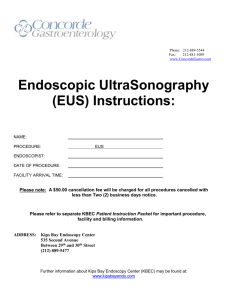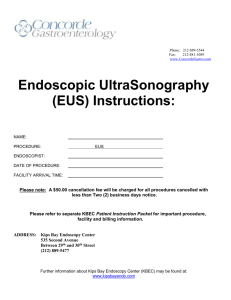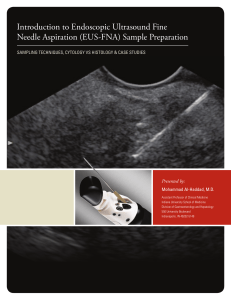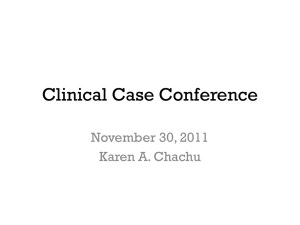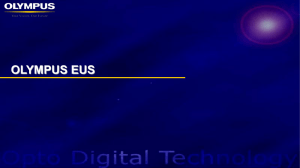Adverse events associated with EUS and EUS with FNA
advertisement
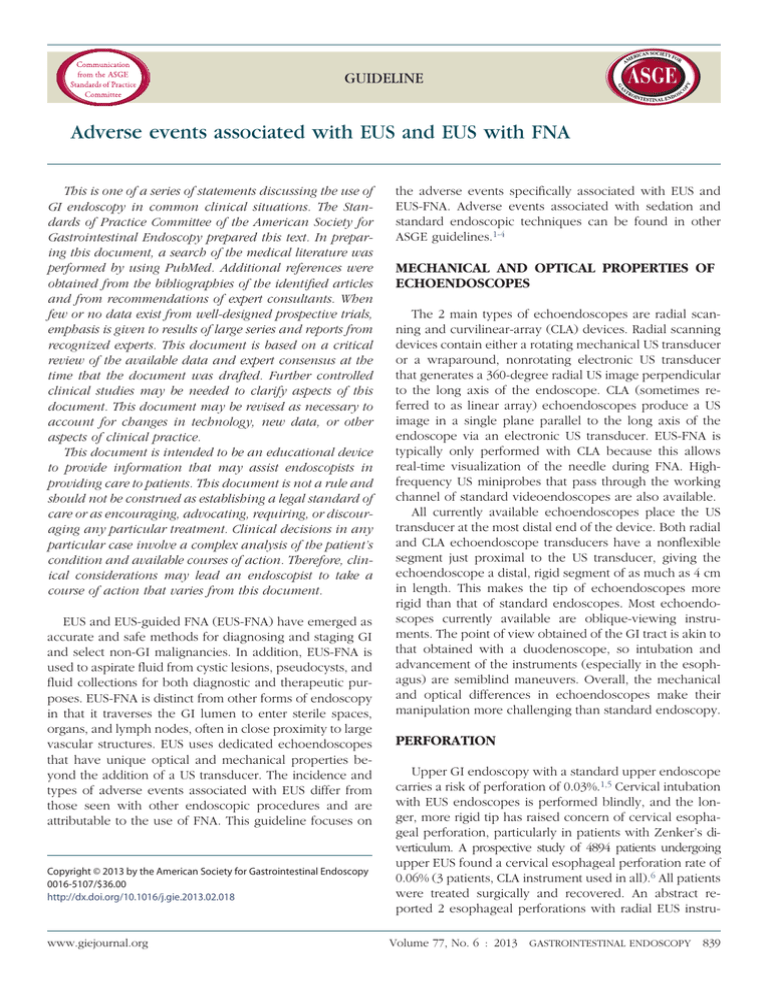
GUIDELINE Adverse events associated with EUS and EUS with FNA This is one of a series of statements discussing the use of GI endoscopy in common clinical situations. The Standards of Practice Committee of the American Society for Gastrointestinal Endoscopy prepared this text. In preparing this document, a search of the medical literature was performed by using PubMed. Additional references were obtained from the bibliographies of the identified articles and from recommendations of expert consultants. When few or no data exist from well-designed prospective trials, emphasis is given to results of large series and reports from recognized experts. This document is based on a critical review of the available data and expert consensus at the time that the document was drafted. Further controlled clinical studies may be needed to clarify aspects of this document. This document may be revised as necessary to account for changes in technology, new data, or other aspects of clinical practice. This document is intended to be an educational device to provide information that may assist endoscopists in providing care to patients. This document is not a rule and should not be construed as establishing a legal standard of care or as encouraging, advocating, requiring, or discouraging any particular treatment. Clinical decisions in any particular case involve a complex analysis of the patient’s condition and available courses of action. Therefore, clinical considerations may lead an endoscopist to take a course of action that varies from this document. EUS and EUS-guided FNA (EUS-FNA) have emerged as accurate and safe methods for diagnosing and staging GI and select non-GI malignancies. In addition, EUS-FNA is used to aspirate fluid from cystic lesions, pseudocysts, and fluid collections for both diagnostic and therapeutic purposes. EUS-FNA is distinct from other forms of endoscopy in that it traverses the GI lumen to enter sterile spaces, organs, and lymph nodes, often in close proximity to large vascular structures. EUS uses dedicated echoendoscopes that have unique optical and mechanical properties beyond the addition of a US transducer. The incidence and types of adverse events associated with EUS differ from those seen with other endoscopic procedures and are attributable to the use of FNA. This guideline focuses on Copyright © 2013 by the American Society for Gastrointestinal Endoscopy 0016-5107/$36.00 http://dx.doi.org/10.1016/j.gie.2013.02.018 www.giejournal.org the adverse events specifically associated with EUS and EUS-FNA. Adverse events associated with sedation and standard endoscopic techniques can be found in other ASGE guidelines.1-4 MECHANICAL AND OPTICAL PROPERTIES OF ECHOENDOSCOPES The 2 main types of echoendoscopes are radial scanning and curvilinear-array (CLA) devices. Radial scanning devices contain either a rotating mechanical US transducer or a wraparound, nonrotating electronic US transducer that generates a 360-degree radial US image perpendicular to the long axis of the endoscope. CLA (sometimes referred to as linear array) echoendoscopes produce a US image in a single plane parallel to the long axis of the endoscope via an electronic US transducer. EUS-FNA is typically only performed with CLA because this allows real-time visualization of the needle during FNA. Highfrequency US miniprobes that pass through the working channel of standard videoendoscopes are also available. All currently available echoendoscopes place the US transducer at the most distal end of the device. Both radial and CLA echoendoscope transducers have a nonflexible segment just proximal to the US transducer, giving the echoendoscope a distal, rigid segment of as much as 4 cm in length. This makes the tip of echoendoscopes more rigid than that of standard endoscopes. Most echoendoscopes currently available are oblique-viewing instruments. The point of view obtained of the GI tract is akin to that obtained with a duodenoscope, so intubation and advancement of the instruments (especially in the esophagus) are semiblind maneuvers. Overall, the mechanical and optical differences in echoendoscopes make their manipulation more challenging than standard endoscopy. PERFORATION Upper GI endoscopy with a standard upper endoscope carries a risk of perforation of 0.03%.1,5 Cervical intubation with EUS endoscopes is performed blindly, and the longer, more rigid tip has raised concern of cervical esophageal perforation, particularly in patients with Zenker’s diverticulum. A prospective study of 4894 patients undergoing upper EUS found a cervical esophageal perforation rate of 0.06% (3 patients, CLA instrument used in all).6 All patients were treated surgically and recovered. An abstract reported 2 esophageal perforations with radial EUS instruVolume 77, No. 6 : 2013 GASTROINTESTINAL ENDOSCOPY 839 Adverse events associated with EUS and EUS-FNA ments in 3006 patients (0.07%),7 and a survey of 86 physicians regarding cervical esophageal perforation reported 16 perforations among 43,852 procedures (0.03%) with 1 death (0.002% mortality rate).8 The majority (94%) of perforations occurred in patients older than 65 years of age, and 44% occurred in patients with a history of difficult intubation during a previous upper endoscopic procedure. Fifteen of 16 perforations (94%) occurred with a radial scanning echoendoscope. Twelve of 16 perforations (75%) were caused by trainees or staff physicians with less than 1 year of experience with upper EUS. Two of the 15 surviving patients required surgical intervention. A recent systematic review reported a perforation rate of 0.02% with EUS (2/10,941).9 Esophageal cancer and esophageal strictures have both been independently linked to an increased incidence of esophageal perforation.1,10,11 A malignant esophageal stricture restricts passage of the echoendoscope in 20% to 30% of EUS examinations for esophageal cancer staging.12 This limits the endosonographer’s ability to completely evaluate tumor depth and to visualize upper abdominal lymph nodes and the liver, potentially decreasing staging accuracy.13,14 Dilation of malignant strictures carries a 0% to 24% risk of perforation.13-17 Prospective studies of dilation in patients with obstructing esophageal cancer undergoing EUS examinations by experienced operators, however, have not found an association between dilation and perforation.16,17 A thinner, tapered-tip, wire-guided, nonoptical echoendoscope (MH-908; Olympus America Corp, Melville, NY) has been shown in 30 patients to significantly increase the frequency of complete staging of otherwise obstructing malignancies without causing perforation.18 Through-the-scope US probes are another alternative in patients with strictures.19-21 In summary, limited data suggest that EUS is associated with a rate of perforation that is similar to standard endoscopy. Lack of operator experience, older patient age, and a history of difficult esophageal intubation may be risk factors for cervical esophageal perforation. Duodenal perforations have also been reported to occur during EUS examinations, but their overall incidence has not been studied.22 No data on the incidence of perforations during EUS in the colon are available. EUS WITH FNA FNA is commonly performed to obtain tissue from masses or lymph nodes, as well as to aspirate the contents of cystic structures (eg, pancreatic cysts) for analysis. In addition, the same needles used to perform FNA can also be used to inject alcohol, corticosteroids, or anesthetic agents to achieve celiac plexus blockade (CPB) or celiac plexus neurolysis (CPN). EUS-FNA needles are available in 19-, 22-, and 25-gauge sizes. Core biopsy needles are available to obtain biopsy specimens for histopathology. Small series with a core biopsy needle indicate that when 840 GASTROINTESTINAL ENDOSCOPY Volume 77, No. 6 : 2013 used by experienced operators, there is no increased risk of adverse events; however, there has been 1 report of an infectious adverse event after core biopsy of a mediastinal mass.23-26 A systematic review of EUS-FNA adverse events found that 22-gauge needles were used in 44 of 51 articles reviewed; therefore, analysis of adverse events based on needle size could not be performed. This review also concluded that adverse event rates are highest for EUSFNA of ascites, liver lesions, and perirectal lesions.9 INFECTIOUS ADVERSE EVENTS Bacteremia is a rare occurrence after diagnostic endoscopy. Several early studies showed an incidence rate of approximately 0% to 8% (excluding patients with biliary obstruction at ERCP).27-29 The frequency of bacteremia as an adverse event of EUS and EUS-FNA has been prospectively studied in 4 separate trials, 1 of which included only rectal EUS.30-33 These studies, which collectively include more than 350 patients, did not find a statistically significant increase in the rate of bacteremia compared with that seen at upper endoscopy, and none of the patients in whom bacteremia developed manifested clinical signs or symptoms of illness. A single case of streptococcal sepsis has been reported among a series of 327 lesions undergoing EUSFNA.34 This occurred in a patient undergoing FNA of a pancreatic serous cystadenoma despite prophylactic antibiotics, and the patient recovered with further antibiotic therapy. Other studies have noted febrile episodes after EUS-FNA at rates of 0.4% to 1%.35,36 Mediastinal cysts are at risk of infection during EUSFNA, even in the setting of prophylactic antibiotic therapy and, if infected, can lead to mediastinitis with or without sepsis.26,37,38 There have been isolated reports of retroperitoneal abscesses after EUS-guided celiac plexus block.39-41 A recent systematic review of adverse events of EUS-FNA reported 1 case of perirectal abscess among 193 patients undergoing EUS-FNA of perirectal lesions and 1 case of fatal cholangitis after EUS-FNA of a hepatic lesion.9 A small case series of perirectal EUS reported 2 cases of pelvic abscess after EUS-FNA of cystic pelvic masses.42 Based on these data, the risk of bacteremia after EUSFNA is low (comparable to that of diagnostic endoscopy)43 and prophylactic antibiotics are not recommended for FNA of solid masses and lymph nodes. Some experts recommend prophylactic antibiotics as well as 48 hours of antibiotics after EUS-FNA of the perirectal space.44 Conversely, EUS-FNA of cystic lesions may carry an increased risk of febrile episodes and possibly sepsis; therefore, prophylactic antibiotics followed by a short postprocedure course have been recommended. Recent data, however, suggest a low rate of adverse events caused by EUS-FNA of pancreatic cysts.45 A recent retrospective cohort study of antibiotic prophylaxis for EUS-FNA of www.giejournal.org Adverse events associated with EUS and EUS-FNA pancreatic cysts identified 1 infection each in 88 patients treated with antibiotics and 178 patients given no antibiotics, as well as 3 antibiotic-related adverse events.46 Prospective data are needed to clarify the risks and benefits of prophylactic antibiotics for EUS-FNA of pancreatic cysts. PANCREATITIS The risk of iatrogenic pancreatitis as a result of EUSFNA arises in patients undergoing FNA of pancreatic masses, cysts, or the pancreatic duct. All of these procedures involve direct passage of the needle through pancreatic tissue. Reported rates of pancreatitis associated with pancreatic EUS-FNA range from 0% to 2%.34,47-50 The risk of pancreatitis does not appear to be influenced by cystic versus solid masses or by the needle gauge used. One study evaluated pancreatitis specifically among 100 patients undergoing EUS-FNA (median 3.4 passes; range 2-9 passes) and found a 2% rate of pancreatitis.50 All patients had blood samples obtained before and 2 hours after the FNA to measure amylase and lipase levels. The 2 patients in whom acute interstitial pancreatitis developed recovered with conservative therapy. A recent metaanalysis of 51 studies found a rate of EUS-FNA–related pancreatitis of 0.44% (36/8246).9 Most cases were classified as mild (75%), although 1 case of severe pancreatitis led to death. There is a single case report of pancreatic duct leak causing symptomatic ascites after EUS-FNA of a pancreatic neck lesion.51 HEMORRHAGE Hemorrhage as an adverse event of EUS-FNA has been described in only a limited fashion. One study reported 2 episodes of clinically significant bleeding after EUS-FNA of pancreatic lesions, one of which resulted in death.48 Mild intraluminal bleeding has been reported to occur in as many as 4% of cases.35 One study specifically evaluated extraluminal hemorrhage in patients undergoing EUS-FNA over a 13-month period.52 Three cases of extraluminal hemorrhage occurred among 227 patients for an overall rate of 1.3%. These occurred during aspiration of a pancreatic islet cell mass, a peritumoral lymph node in a patient with esophageal cancer, and a pancreatic cyst. In all cases, the hemorrhage was seen with US, and mechanical pressure to tamponade the hemorrhage was successfully applied with the endoscope. A prospective, controlled study specifically evaluated bleeding rates after EUS-FNA in patients taking aspirin/nonsteroidal antiinflammatory drugs and low molecular weight heparin. Compared with EUS-FNA in patients on none of these agents, bleeding was significantly more likely in patients on low molecular weight heparin (33.3% vs 3.7%, P ⫽ .023).53 A recent meta-analysis of EUS-FNA adverse events reported a bleeding rate of 0.13% (14/10,941).9 There are www.giejournal.org no data on whether the gauge of the needle or the technique influences the risk of bleeding with EUS-FNA. BILE PERITONITIS Bile peritonitis is a rare adverse event of EUS-FNA. There is one report of bile peritonitis after EUS-FNA of a pancreatic-head mass requiring laparotomy.54 During a study of the use of EUS-FNA to obtain bile directly from the gallbladder in an attempt to identify patients with microlithiasis, bile peritonitis developed in 2 of the first 3 patients, resulting in termination of the study.55 EUS-FNA of solid gallbladder masses was shown to be safe in 2 small case series.56,57 MALIGNANT SEEDING EUS-FNA frequently involves a needle advanced from the lumen across the GI tract into adjacent malignant tissue. There are 3 case reports of tumor seeding along an FNA needle path; 1 each of pancreatic cancer, melanoma (both transgastric), and malignant mediastinal lymphadenopathy (transesophageal). EUS WITH CPB/CPN EUS can be used to perform CPB or CPN as a means of achieving analgesia. The technique involves the delivery of corticosteroids (in blockade) or absolute alcohol (in neurolysis) plus a local anesthetic into the celiac plexus via EUS-guided injection with an FNA needle. Adverse events associated with this procedure include transient diarrhea (4%-15%), transient orthostasis (1%), transient increases in pain (9%), and abscess formation.39,40 Patients should receive adequate intravenous hydration before and after the procedure to reduce the incidence of orthostasis. A large case series of 189 CPB and 31 CPN reported 1 case of asymptomatic hypotension after neurolysis, 1 case of retroperitoneal abscess after CPB, and 2 cases of severe self-limited postprocedural pain after CPB.41 The incidence of adverse events with EUS-guided CPN is similar to adverse events associated with percutaneous CPN. Although it was postulated that the anterior approach for CPN offered by EUS would avoid the rare but highly disabling adverse event of spinal cord infarction associated with the posterior percutaneous approach, there is now a single case report of anterior spinal cord infarction with permanent paralysis after EUS-guided CPN.58,59 Death resulting from EUS-guided CPB or CPN has not been reported.60,61 EUS-GUIDED BILIARY AND PANCREATIC ACCESS EUS-guided pancreaticobiliary access is a relatively new technique to access biliary and pancreatic ducts via EUSVolume 77, No. 6 : 2013 GASTROINTESTINAL ENDOSCOPY 841 Adverse events associated with EUS and EUS-FNA guided needle puncture through the gastric or duodenal wall. The technique was developed as a salvage therapy when conventional ERCP fails to achieve pancreaticobiliary access, often because of altered anatomy. Small published series report success rates of 50% to 85%, with adverse event rates ranging from 10% to 16%.62,63 CONCLUSIONS Adverse events are inherent in the performance of EUS and EUS-FNA. As these procedures assume larger roles in the management of GI and non-GI disorders, the potential for adverse events will likely increase. Knowledge of potential adverse events secondary to EUS and EUS-FNA, their expected frequency, and their associated risk factors may help to minimize their occurrence. Endoscopists are expected to carefully select patients for the appropriate intervention, be familiar with the planned procedure and available technology, and be prepared to manage any adverse events that may arise. Once an adverse event occurs, early recognition and prompt intervention may minimize the morbidity and mortality associated with that adverse event. Review of adverse events as part of a continuing quality improvement process may serve to educate endoscopists, help to reduce the risk of future adverse events, and improve the overall quality of endoscopy. DISCLOSURE The following author disclosed a financial relationship relevant to this publication: Dr Fisher, consultant to Epigenomics, Inc; Dr Hwang, consultant to U.S. Endoscopy and speaker for Novartis; Dr Pasha, research support from Capervision. The other authors disclosed no financial relationships relevant to this publication. Abbreviations: CLA, curvilinear array; CPB, celiac plexus blockade; CPN, celiac plexus neurolysis; EUS-FNA, EUS-guided FNA. REFERENCES 1. Eisen GM, Baron TH, Dominitz JA, et al. Complications of upper GI endoscopy. Gastrointest Endosc 2002;55:784-93. 2. ASGE Standard of Practice Committee, Fisher DA, Maple JT, BenMenachem T, et al. Complications of colonoscopy. Gastrointest Endosc 2011;74:745-52. 3. ASGE Standard of Practice Committee, Anderson MA, Fisher L, Jain R, et al. Complications of ERCP. Gastrointest Endosc 2012;75:467-73. 4. ASGE Standard of Practice Committee, Lichtenstein DR, Jagannath S, Baron TH, et al. Sedation and anesthesia in GI endoscopy. Gastrointest Endosc 2008;68:815-26. 5. Silvis SE, Nebel O, Rogers G, et al. Endoscopic complications Results of the 1974 American Society for Gastrointestinal Endoscopy Survey. JAMA 1976;235:928-30. 6. Eloubeidi MA, Tamhane A, Lopes TL, et al. Cervical esophageal perforations at the time of endoscopic ultrasound: a prospective evaluation of frequency, outcomes, and patient management. Am J Gastroenterol 2009;104:53-6. 842 GASTROINTESTINAL ENDOSCOPY Volume 77, No. 6 : 2013 7. Rathod VD, Maydeo A. How safe is endoscopic ultrasound? A retrospective analysis of complications encountered during diagnosis and interventional endosonography in a large individual series of 3006 patients from India [abstract]. Gastrointest Endosc 2002;56:AB169. 8. Das A, Sivak MV Jr, Chak A. Cervical esophageal perforation during EUS: a national survey. Gastrointest Endosc 2001;53:599-602. 9. Wang KX, Ben QW, Jin ZD, et al. Assessment of morbidity and mortality associated with EUS-guided FNA: a systematic review. Gastrointest Endosc 2011;73:283-90. 10. Schulze S, Móller Pedersen V, Høier-Madsen K, et al. Iatrogenic perforation of the esophagus. Causes and management. Acta Chir Scand 1982; 148:679-82. 11. Pettersson G, Larsson S, Gatzinsky P, et al. Differentiated treatment of intrathoracic oesophageal perforations. Scand J Thorac Card Surg 1981; 15:321-4. 12. Keswani RN, Early DS, Edmundowicz SA, et al. Routine positron emission tomography does not alter nodal staging in patients undergoing EUSguided FNA for esophageal cancer. Gastrointest Endosc 2009;69: 1210-7. 13. Catalano MF, Van Dam J, Sivak MV Jr. Malignant esophageal strictures: staging accuracy of endoscopic ultrasonography. Gastrointest Endosc 1995;41:535-9. 14. Van Dam J, Rice TW, Catalano MF, et al. High-grade malignant stricture is predictive of esophageal tumor stage. Risks of endosonographic evaluation. Cancer 1993;71:2910-7. 15. Kallimanis GE, Gupta PK, al-Kawas FH, et al. Endoscopic ultrasound for staging esophageal cancer, with or without dilation, is clinically important and safe. Gastrointest Endosc 1995;41:540-6. 16. Pfau PR, Ginsberg GG, Lew RJ, et al. Esophageal dilation for endosonographic evaluation of malignant esophageal strictures is safe and effective. Am J Gastroenterol 2000;95:2813-5. 17. Wallace MB, Hawes RH, Sahai AV, et al. Dilation of malignant esophageal stenosis to allow EUS guided fine-needle aspiration: safety and effect on patient management. Gastrointest Endosc 2000;51:309-13. 18. Mallery S, Van Dam J. Increased rate of complete EUS staging of patients with esophageal cancer using the nonoptical, wire-guided echoendoscope. Gastrointest Endosc 1999;50:53-7. 19. Menzel J, Hoepffner N, Nottberg H, et al. Preoperative staging of esophageal carcinoma: miniprobe sonography versus conventional endoscopic ultrasound in a prospective histopathologically verified study. Endoscopy 1999;31:291-7. 20. Fockens P, van Dullemen HM, Tytgat GN. Endosonography of stenotic esophageal carcinomas: preliminary experience with an ultra-thin, balloon-fitted ultrasound probe in four patients. Gastrointest Endosc 1994;40:226-8. 21. Chak A, Canto M, Stevens PD, et al. Clinical applications of a new through-the-scope ultrasound probe: prospective comparison with an ultrasound endoscope. Gastrointest Endosc 1997;45:291-5. 22. Raut CP, Grau AM, Staerkel GA, et al. Diagnostic accuracy of endoscopic ultrasound-guided fine-needle aspiration in patients with presumed pancreatic cancer. J Gastrointest Surg 2003;7:118-26; discussion 127-8. 23. Wiersema MJ, Levy MJ, Harewood GC, et al. Initial experience with EUSguided trucut needle biopsies of perigastric organs. Gastrointest Endosc 2002;56:275-8. 24. Levy MJ, Jondal ML, Clain J, et al. Preliminary experience with an EUSguided trucut biopsy needle compared with EUS-guided FNA. Gastrointest Endosc 2003;57:101-6. 25. Larghi A, Verna EC, Stavropoulos SN, et al. EUS-guided trucut needle biopsies in patients with solid pancreatic masses: a prospective study. Gastrointest Endosc 2004;59:185-90. 26. Wildi SM, Hoda RS, Fickling W, et al. Diagnosis of benign cysts of the mediastinum: the role and risks of EUS and FNA. Gastrointest Endosc 2003;58:362-8. 27. Coughlin GP, Butler RN, Alp MH, et al. Colonoscopy and bacteraemia. Gut 1977;18:678-9. 28. Botoman VA, Surawicz CM. Bacteremia with gastrointestinal endoscopic procedures. Gastrointest Endosc 1986;32:342-6. www.giejournal.org Adverse events associated with EUS and EUS-FNA 29. Baltch AL, Buhac I, Agrawal A, et al. Bacteremia after upper gastrointestinal endoscopy. Arch Intern Med 1977;137:594-7. 30. Barawi M, Gottlieb K, Cunha B, et al. A prospective evaluation of the incidence of bacteremia associated with EUS-guided fine-needle aspiration. Gastrointest Endosc 2001;53:189-92. 31. Levy MJ, Norton ID, Wiersema MJ, et al. Prospective risk assessment of bacteremia and other infectious complications in patients undergoing EUS-guided FNA. Gastrointest Endosc 2003;57:672-8. 32. Janssen J, Konig K, Knop-Hammad V, et al. Frequency of bacteremia after linear EUS of the upper GI tract with and without FNA. Gastrointest Endosc 2004;59:339-44. 33. Levy MJ, Norton ID, Clain JE, et al. Prospective study of bacteremia and complications With EUS FNA of rectal and perirectal lesions. Clin Gastroenterol Hepatol 2007;5:684-9. 34. Williams DB, Sahai AV, Aabakken L, et al. Endoscopic ultrasound guided fine needle aspiration biopsy: a large single centre experience. Gut 1999;44:720-6. 35. Voss M, Hammel P, Molas G, et al. Value of endoscopic ultrasound guided fine needle aspiration biopsy in the diagnosis of solid pancreatic masses. Gut 2000;46:244-9. 36. Chang KJ, Nguyen P, Erickson RA, et al. The clinical utility of endoscopic ultrasound-guided fine-needle aspiration in the diagnosis and staging of pancreatic carcinoma. Gastrointest Endosc 1997;45:387-93. 37. Ryan AG, Zamvar V, Roberts SA. Iatrogenic candidal infection of a mediastinal foregut cyst following endoscopic ultrasound-guided fineneedle aspiration. Endoscopy 2002;34:838-9. 38. Diehl DL, Cheruvattath R, Facktor MA, et al. Infection after endoscopic ultrasound-guided aspiration of mediastinal cysts. Interact Cardiovasc Thorac Surg 2010;10:338-40. 39. Gress F, Schmitt C, Sherman S, et al. Endoscopic ultrasound-guided celiac plexus block for managing abdominal pain associated with chronic pancreatitis: a prospective single center experience. Am J Gastroenterol 2001;96:409-16. 40. Hoffman BJ. EUS-guided celiac plexus block/neurolysis. Gastrointest Endosc 2002;56(4 Suppl):S26-28. 41. O’Toole TM, Schmulewitz N. Complication rates of EUS-guided celiac plexus blockade and neurolysis: results of a large case series. Endoscopy 2009;41:593-7. 42. Mohamadnejad M, Al-Haddad MA, Sherman S, et al. Utility of EUSguided biopsy of extramural pelvic masses. Gastrointest Endosc 2012; 75:146-51. 43. Hirota WK, Petersen K, Baron TH, et al. Guidelines for antibiotic prophylaxis for GI endoscopy. Gastrointest Endosc 2003;58:475-82. 44. Schwartz DA, Harewood GC, Wiersema MJ. EUS for rectal disease. Gastrointest Endosc 2002;56:100-9. 45. Lee LS, Saltzman JR, Bounds BC, et al. EUS-guided fine needle aspiration of pancreatic cysts: a retrospective analysis of complications and their predictors. Clin Gastroenterol Hepatol 2005;3:231-6. 46. Guarner-Argente C, Shah P, Buchner A, et al. Use of antimicrobials for EUS-guided FNA of pancreatic cysts: a retrospective, comparative analysis. Gastrointest Endosc 2011;74:81-6. 47. O’Toole D, Palazzo L, Arotcarena R, et al. Assessment of complications of EUS-guided fine-needle aspiration. Gastrointest Endosc 2001;53:470-4. 48. Gress FG, Hawes RH, Savides TJ, et al. Endoscopic ultrasound-guided fine-needle aspiration biopsy using linear array and radial scanning endosonography. Gastrointest Endosc 1997;45:243-50. 49. Eloubeidi MA, Chen VK, Eltoum IA, et al. Endoscopic ultrasound-guided fine needle aspiration biopsy of patients with suspected pancreatic cancer: diagnostic accuracy and acute and 30-day complications. Am J Gastroenterol 2003;98:2663-8. 50. Gress F, Michael H, Gelrud D, et al. EUS-guided fine-needle aspiration of the pancreas: evaluation of pancreatitis as a complication. Gastrointest Endosc 2002;56:864-7. www.giejournal.org 51. Reddymasu S, Oropeza-Vail MM, Williamson S, et al Pancreatic leak after endoscopic ultrasound guided fine needle aspiration managed by transpapillary pancreatic duct stenting. JOP 2011;12:489-90. 52. Affi A, Vazquez-Sequeiros E, Norton ID, et al. Acute extraluminal hemorrhage associated with EUS-guided fine needle aspiration: frequency and clinical significance. Gastrointest Endosc 2001;53:221-5. 53. Kien-Fong Vu C, Chang F, Doig L, et al. A prospective control study of the safety and cellular yield of EUS-guided FNA or Trucut biopsy in patients taking aspirin, nonsteroidal anti-inflammatory drugs, or prophylactic low molecular weight heparin. Gastrointest Endosc 2006;63:808-13. 54. Chen HY, Lee CH, Hsieh CH. Bile peritonitis after EUS-guided fine-needle aspiration. Gastrointest Endosc 2002;56:594-6. 55. Jacobson BC, Waxman I, Parmar K, et al. Endoscopic ultrasound-guided gallbladder bile aspiration in idiopathic pancreatitis carries a significant risk of bile peritonitis. Pancreatology 2002;2:26-9. 56. Jacobson BC, Pitman MB, Brugge WR. EUS-guided FNA for the diagnosis of gallbladder masses. Gastrointest Endosc 2003;57:251-4. 57. Meara RS, Jhala D, Eloubeidi MA, et al. Endoscopic ultrasound-guided FNA biopsy of bile duct and gallbladder: analysis of 53 cases. Cytopathology 2006;17:42-9. 58. Fujii L, Clain JE, Morris JM, et al. Anterior spinal cord infarction with permanent paralysis following endoscopic ultrasound celiac plexus neurolysis. Endoscopy 2012;44(Suppl 2):E265-6. 59. Eisenberg E, Carr DB, Chalmers TC. Neurolytic celiac plexus block for treatment of cancer pain: a meta-analysis. Anesth Analg 1995;80:290-5. 60. Levy MJ, Wiersema MJ. EUS-guided celiac plexus neurolysis and celiac plexus block. Gastrointest Endosc 2003;57:923-30. 61. Schmulewitz N, Hawes R. EUS-guided celiac plexus neurolysis-technique and indication. Endoscopy 2003;35:S49-53. 62. Iwashita T, Lee JG. Endoscopic ultrasonography-guided biliary drainage: rendezvous technique. Gastrointest Endosc Clin N Am 2012;22:249-58, viii-ix. 63. Shah JN, Marson F, Weilert F, et al. Single-operator, single-session EUSguided anterograde cholangiopancreatography in failed ERCP or inaccessible papilla. Gastrointest Endosc 2012;75:56-64. Prepared by: ASGE STANDARDS OF PRACTICE COMMITTEE Dayna S. Early, MD Ruben D. Acosta, MD Vinay Chandrasekhara, MD Krishnavel V. Chathadi, MD G. Anton Decker, MD John A. Evans, MD Robert D. Fanelli, MD, SAGES Representative Deborah A. Fisher, MD Lisa Fonkalsrud, RN, SGNA Representative Joo Ha Hwang, MD Terry L. Jue, MD Mouen A. Khashab, MD Jenifer R. Lightdale, MD V. Raman Muthusamy, MD Shabana F. Pasha, MD John R. Saltzman, MD Ravi N. Sharaf, MD Amandep K. Shergill, MD Brooks D. Cash, MD (Chair) This document is a product of the Standards of Practice Committee. This document was reviewed and approved by the Governing Board of the American Society for Gastrointestinal Endoscopy. Volume 77, No. 6 : 2013 GASTROINTESTINAL ENDOSCOPY 843
